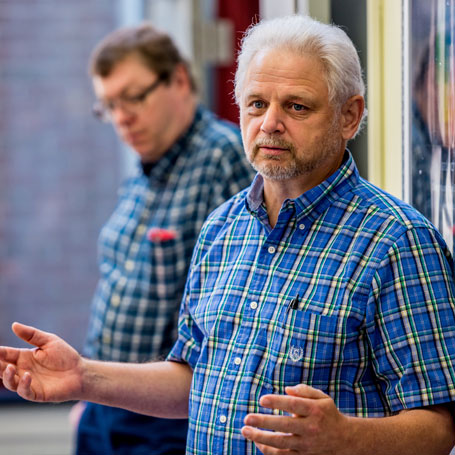Broughton Had Right Equation for Math Department

Summing it Up: Allen Broughton, head of the Department of Mathematics for 20 years, worked with other academic departments and supported faculty in course development and new degree programs, including the most recent launch of a biomathematics major.
As an accomplished math scholar, Allen Broughton has examined the complexities of Riemann surfaces, a mathematical configuration known for having many complicated structures and interconnections.
So it is only fitting that, in his 20 years leading Rose-Hulman’s math department, Broughton found connections between mathematics and computer science, chemistry, biology and physics.
Collaborations with other academic departments fostered double-major and two-degree programs, a major in biomathematics, a second major in computational science, minors in computational science and biomathematics, and course development in the expanding field of big data. The number of math graduates also has grown steadily throughout the years.
“I built a strong team that established partnerships that considered where math is being used in the real world,” says Broughton, who retired at the end of the 2016-17 school year.
“Mathematics is such a fundamental part of the Rose-Hulman experience. I wanted to take advantage of Rose-Hulman’s strengths in science, technology, engineering and mathematics (STEM) to showcase the interdependent relationships between each element of STEM,” he remarks. “Mathematics has become an even more important element of science and computing.”
As a case in point, Broughton helped develop a new course that examined the mathematics of image processing, and joined with Rose-Hulman math colleague Kurt Bryan to write a textbook (second edition now underway) that explained for undergraduate audiences the application of discrete Fourier analysis and wavelets to signal and image processing.
Broughton joined several colleagues, from chemistry to optical engineering, in writing a textbook introducing the science of nanotechnology, and incorporated other topics such as Lie groups and algebras into Rose-Hulman’s mathematics curriculum.
Also, in recent years Broughton helped enhance the quality of research experiences for undergraduate students through the Weaver and Rose-Hulman summer research programs, in collaboration with the Interdisciplinary Research Collaborative. Through these programs alone, a record 16 students will be working on science, engineering and mathematics projects this summer with faculty mentors.
“These projects provide cutting-edge opportunities that students wouldn’t get in the classroom, preparing them for graduate school or research and development positions in industry. These expanding research programs have been of value to me, and the students benefit from them greatly as well,” says Broughton, a native Canadian who came to Rose-Hulman in 1994 after teaching at Memorial University of Newfoundland, University of Wisconsin and Cleveland State University.
Throughout his Rose-Hulman career Broughton forged relationships with global educators and universities in Sweden, Spain, Poland, Germany, New Zealand and countries in the United Kingdom.